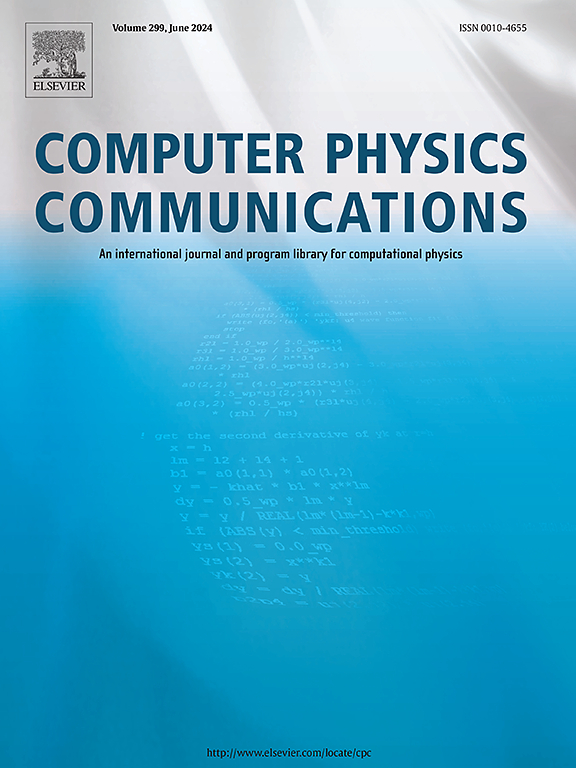TeNeS-v2:增强量子多体系统的实时和有限温度模拟
IF 3.4
2区 物理与天体物理
Q1 COMPUTER SCIENCE, INTERDISCIPLINARY APPLICATIONS
引用次数: 0
摘要
量子多体系统由于具有大量的自由度而成为计算物理学研究的一个极具挑战性的目标。张量网络,特别是张量积态(TPS)和投影纠缠对态(PEPS),在二维晶格上有效地表示了这些系统。然而,基于TPS/ pep编码的技术复杂性对许多研究人员来说是一个挑战,无法有效地管理。为了减少这个问题,我们开发了TeNeS(张量网络求解器)。本文介绍了TeNeS-v2,它扩展了TeNeS的实时和有限温度模拟,为量子多体系统提供了更深入的见解。我们详细介绍了新的算法、输入/输出设计和应用实例,展示了TeNeS-v2在二维晶格上的各种量子自旋和玻色模型的适用性。新版本程序摘要程序名称:TeNeSCPC库程序文件链接:https://doi.org/10.17632/psm26xxbvd.2Developer's存储库链接:https://github.com/issp-center-dev/TeNeSLicensing条款:gplv3编程语言:c++ 11上一版本的期刊参考:Comput。理论物理。Commun。(2022) 279, 108437, doi:10.1016/j.c cp .2022.108437新版本的原因:扩展TeNeS的功能,包括实时和有限温度模拟,从而能够更深入地了解基态以外的量子多体系统。修订总结:TeNeS-v2引入了实时演化和有限温度模拟功能,扩大了可以研究的量子多体现象的范围。问题性质:由于希尔伯特空间的巨大维度,量子多体系统极难模拟。传统的方法很难准确地表示这些系统,特别是对于小晶格和基态以外的性质。需要先进的计算技术来有效地捕捉这些系统的动力学和热特性。求解方法:TeNeS采用张量网络,特别是张量积态(TPS)和投影纠缠对态(PEPS),在二维晶格上有效地表示量子多体态。实时演化是通过虚时间演化方法的直接扩展来处理的,允许动态特性的研究。从无限温度混合状态出发,采用虚时间演化方法进行有限温度模拟。这些方法能够精确计算不同量子态下的各种物理性质。附加评论,包括限制和不寻常的功能:TeNeS-v2通过提供灵活的输入文件配置和支持各种二维晶格模型来保持易用性。增加键的尺寸以提高精度需要更多的计算资源。有限温度计算由于张量网络近似方法的限制可能会表现出非物理行为。用户应该意识到这些潜在的问题,并根据文本中提出的建议来解释结果。本文章由计算机程序翻译,如有差异,请以英文原文为准。
TeNeS-v2: Enhancement for real-time and finite temperature simulations of quantum many-body systems
Quantum many-body systems are challenging targets for computational physics due to their large number of degrees of freedom. The tensor networks, particularly Tensor Product States (TPS) and Projected Entangled Pair States (PEPS), effectively represent these systems on two-dimensional lattices. However, the technical complexity of TPS/PEPS-based coding can be challenging for many researchers to manage effectively. To reduce this problem, we developed TeNeS (Tensor Network Solver). This paper introduces TeNeS-v2, which extends TeNeS with real-time and finite temperature simulations, providing deeper insights into quantum many-body systems. We detail the new algorithms, input/output design, and application examples, demonstrating TeNeS-v2's applicability to various quantum spin and Bose models on two-dimensional lattices.
New version program summary
Program Title: TeNeS
CPC Library link to program files: https://doi.org/10.17632/psm26xxbvd.2
Developer's repository link: https://github.com/issp-center-dev/TeNeS
Licensing provisions: GPLv3
Programming language: C++11
Journal reference of previous version: Comput. Phys. Commun. (2022) 279, 108437, doi:10.1016/j.cpc.2022.108437
Reasons for the new version: To extend the capabilities of TeNeS to include real-time and finite temperature simulations, enabling deeper insights into quantum many-body systems beyond ground states.
Summary of revisions: TeNeS-v2 introduces real-time evolution and finite temperature simulation capabilities, expanding the range of quantum many-body phenomena that can be studied.
Nature of problem: Quantum many-body systems are extremely difficult to simulate because of the huge dimension of the Hilbert space. Conventional methods have difficulty in accurately representing these systems, especially for properties beyond small lattices and ground states. Advanced computational techniques are required to efficiently capture the dynamics and thermal properties of these systems.
Solution method: TeNeS employs tensor networks, specifically Tensor Product States (TPS) and Projected Entangled Pair States (PEPS), to efficiently represent quantum many-body states on two-dimensional lattices. The real-time evolution is handled through a straightforward extension of imaginary time evolution methods, allowing the study of dynamical properties. Finite temperature simulations are conducted using an imaginary time evolution approach starting from the infinite-temperature mixed state. These methods enable the accurate calculation of various physical properties in different quantum states.
Additional comments including restrictions and unusual features: TeNeS-v2 maintains ease of use by providing flexible input file configurations and supporting a variety of two-dimensional lattice models. Increasing the bond dimension to improve accuracy requires more computational resources. Finite temperature calculations may exhibit unphysical behavior due to limitations of the tensor network approximation method. Users should be aware of these potential problems and interpret the results following the suggestions made in the text.
求助全文
通过发布文献求助,成功后即可免费获取论文全文。
去求助
来源期刊

Computer Physics Communications
物理-计算机:跨学科应用
CiteScore
12.10
自引率
3.20%
发文量
287
审稿时长
5.3 months
期刊介绍:
The focus of CPC is on contemporary computational methods and techniques and their implementation, the effectiveness of which will normally be evidenced by the author(s) within the context of a substantive problem in physics. Within this setting CPC publishes two types of paper.
Computer Programs in Physics (CPiP)
These papers describe significant computer programs to be archived in the CPC Program Library which is held in the Mendeley Data repository. The submitted software must be covered by an approved open source licence. Papers and associated computer programs that address a problem of contemporary interest in physics that cannot be solved by current software are particularly encouraged.
Computational Physics Papers (CP)
These are research papers in, but are not limited to, the following themes across computational physics and related disciplines.
mathematical and numerical methods and algorithms;
computational models including those associated with the design, control and analysis of experiments; and
algebraic computation.
Each will normally include software implementation and performance details. The software implementation should, ideally, be available via GitHub, Zenodo or an institutional repository.In addition, research papers on the impact of advanced computer architecture and special purpose computers on computing in the physical sciences and software topics related to, and of importance in, the physical sciences may be considered.
 求助内容:
求助内容: 应助结果提醒方式:
应助结果提醒方式:


